Experimental and Theoretical Study on Operation Characteristics of an Oscillating Heat Pipe
Abstract
:1. Introduction
2. Experimental Setup
2.1. OHP Test System
2.2. Experimental Data Reduction
2.3. Uncertainty Analysis
3. Mathematical Analysis
3.1. Equivalent Thermal Conductivity
3.2. Extended Thermal Resistance
4. Results and Discussion
4.1. Temperature Variation
4.2. Thermal Resistance Analysis
4.3. Thermal Resistance Correlation
5. Conclusions
- (1)
- The initial start-up period and stable oscillating period can be clarified during the operation of an OHP. As the heating power increased from 25 to 62.5 W, the trends of the temperature oscillation were similar. However, the temperature oscillation presented a large fluctuation associated with the occasional large amplitude and low frequency at the high heating input.
- (2)
- Thermal resistance showed an oscillation with a large amplitude and lower frequency during the start-up period. During the stable operation period, the oscillation exhibited small amplitude and high frequency. As the heating power increases, the thermal resistance decreases simultaneously. It showed an optimal thermal performance at a heating input of 75 W for the studied OHP system.
- (3)
- The reciprocal of the radial heat transfer coefficient increased with increasing liquid film thickness. As a result, an empirical linear correlation using regression coefficients was found to be able to describe the relationship between the thermal resistances and heating inputs. This has been proven using experimental data both in this study and from the literature.
Author Contributions
Funding
Institutional Review Board Statement
Informed Consent Statement
Data Availability Statement
Conflicts of Interest
References
- Akachi, H. Structure of a Heat Pipe. U.S. Patent 4,921,041, 1 May 1990. [Google Scholar]
- Ma, H. Oscillating Heat Pipes; Springer: New York, NY, USA, 2015. [Google Scholar]
- Khandekar, S.; Dollinger, N.; Groll, M. Understanding operational regimes of pulsating heat pipes: An experimental study. Appl. Therm. Eng. 2003, 23, 707–719. [Google Scholar] [CrossRef] [Green Version]
- Charoensawan, P.; Khandekar, S.; Terdtoon Groll, M. Closed loop pulsating heat pipes A: Parametric experimental investigations. Appl. Therm. Eng. 2003, 23, 2009–2020. [Google Scholar] [CrossRef]
- Ghiaasiaan, S.M. Two-Phase Flow, Boiling, and Condensation: In Conventional and Miniature Systems; Cambridge University Press: Cambridge, MA, USA, 2007. [Google Scholar]
- Xu, R.J.; Wang, R.X.; Cong, W.; Wu, Y. Design of pulsating heat pipe experiment rig and visual experiment study. Fluid Mach. 2007, 35, 59–62. [Google Scholar]
- Li, J.; Han, Z.; Li, Z.; Liu, S. Visual experiment study on operation and heat transfer characteristics of the pulsating heat pipes. Mod. Chem. Ind. 2008, 11, 016. [Google Scholar]
- Xu, G.; Liang, S.; Vogel, M.; Katoh, T. Thermal characterization of pulsating heat pipes. In Proceedings of the Thermal and Thermomechanical Proceedings 10th Intersociety Conference on Phenomena in Electronics Systems, 2006. ITHERM 2006, San Diego, CA, USA, 30 May–2 June 2006. [Google Scholar]
- Smoot, C.D.; Ma, H.B.; Wilson, C.A. Heat conduction effect on oscillating heat pipe operation. J. Therm. Sci. Eng. Appl. 2011, 3, 024501. [Google Scholar] [CrossRef]
- Thompson, S.M.; Ma, H.B.; Wilson, C. Investigation of a flat-plate oscillating heat pipe with Tesla-type check valves. Exp. Therm. Fluid Sci. 2011, 35, 1265–1273. [Google Scholar] [CrossRef]
- Thompson, S.M.; Hathaway, A.A.; Smoot, C.D.; Wilson, C.A.; Ma, H.B.; Young, R.M.; Greenberg, L.; Osick, B.R.; Van Campen, S.; Morgan, B.C.; et al. Robust thermal performance of a flat-plate oscillating heat pipe during high-gravity loading. J. Heat Transf. 2011, 133, 104504. [Google Scholar] [CrossRef]
- Cui, X.; Zhu, Y.; Li, Z.; Shun, S. Combination study of operation characteristics and heat transfer mechanism for pulsating heat pipe. Appl. Therm. Eng. 2014, 65, 394–402. [Google Scholar] [CrossRef]
- Rahman, M.L.; Sultan, R.A.; Islam, T.; Hasan, N.M.; Ali, M. An experimental investigation on the effect of fin in the performance of closed loop pulsating heat pipe (CLPHP). Procedia Eng. 2015, 105, 137–144. [Google Scholar] [CrossRef] [Green Version]
- Kearney, D.J.; Suleman, O.; Griffin, J.; Mavrakis, G. Thermal performance of a PCB embedded pulsating heat pipe for power electronics applications. Appl. Therm. Eng. 2016, 98, 798–809. [Google Scholar] [CrossRef]
- Qu, J.; Zhao, J.; Rao, Z. Experimental investigation on the thermal performance of three-dimensional oscillating heat pipe. Int. J. Heat Mass Transf. 2017, 109, 589–600. [Google Scholar] [CrossRef]
- Dang, C.; Jia, L.; Lu, Q. Investigation on thermal design of a rack with the pulsating heat pipe for cooling CPUs. Appl. Therm. Eng. 2017, 110, 390–398. [Google Scholar] [CrossRef]
- Tokuda, D.; Inoue, T. Heat transport characteristics of a sodium oscillating heat pipe: Thermal performance. Int. J. Heat Mass Transf. 2022, 196, 123281. [Google Scholar] [CrossRef]
- Ando, M.; Okamoto, A.; Nagai, H. Start-up and heat transfer characteristics of oscillating heat pipe with different check valve layouts. Appl. Therm. Eng. 2021, 196, 117286. [Google Scholar] [CrossRef]
- Iwata, N.; Miyazaki, Y.; Yasuda, S.; Ogawa, I. Thermal performance and flexibility evaluation of metallic micro oscillating heat pipe for thermal strap. Appl. Therm. Eng. 2021, 197, 117342. [Google Scholar] [CrossRef]
- Wang, H.; Qu, J.; Peng, Y.; Sun, Q. Heat transfer performance of a novel tubular oscillating heat pipe with sintered copper particles inside flat-plate evaporator and high-power LED heat sink application. Energy Convers. Manag. 2019, 189, 215–222. [Google Scholar] [CrossRef]
- Taft, B.S.; Williams, A.D.; Drolen, B.L. Review of pulsating heat pipe working fluid selection. J. Thermophys. Heat Transf. 2012, 26, 651–656. [Google Scholar] [CrossRef]
- Bell, S. A Beginner’s Guide to Uncertainty of Measurement; National Physical Laboratory: Teddington, UK, 2001. [Google Scholar]
- Stephan, K. Influence of dispersion forces on phase equilibria between thin liquid films and their vapour. Int. J. Heat Mass Transf. 2002, 45, 4715–4725. [Google Scholar] [CrossRef]
- Park, K.; Lee, K.S. Flow and heat transfer characteristics of the evaporating extended meniscus in a micro-capillary channel. Int. J. Heat Mass Transf. 2003, 46, 4587–4594. [Google Scholar] [CrossRef]
- Schetz, J.A.; Fuhs, A.E. Fundamentals of Fluid Mechanics; John Wiley & Sons: Hoboken, NJ, USA, 1999. [Google Scholar]
- Yarin, L.P.; Mosyak, A.; Hetsroni, G. Fluid Flow, Heat Transfer and Boiling in Micro-Channels; Springer Science & Business Media: Berlin/Heidelberg, Germany, 2008. [Google Scholar]
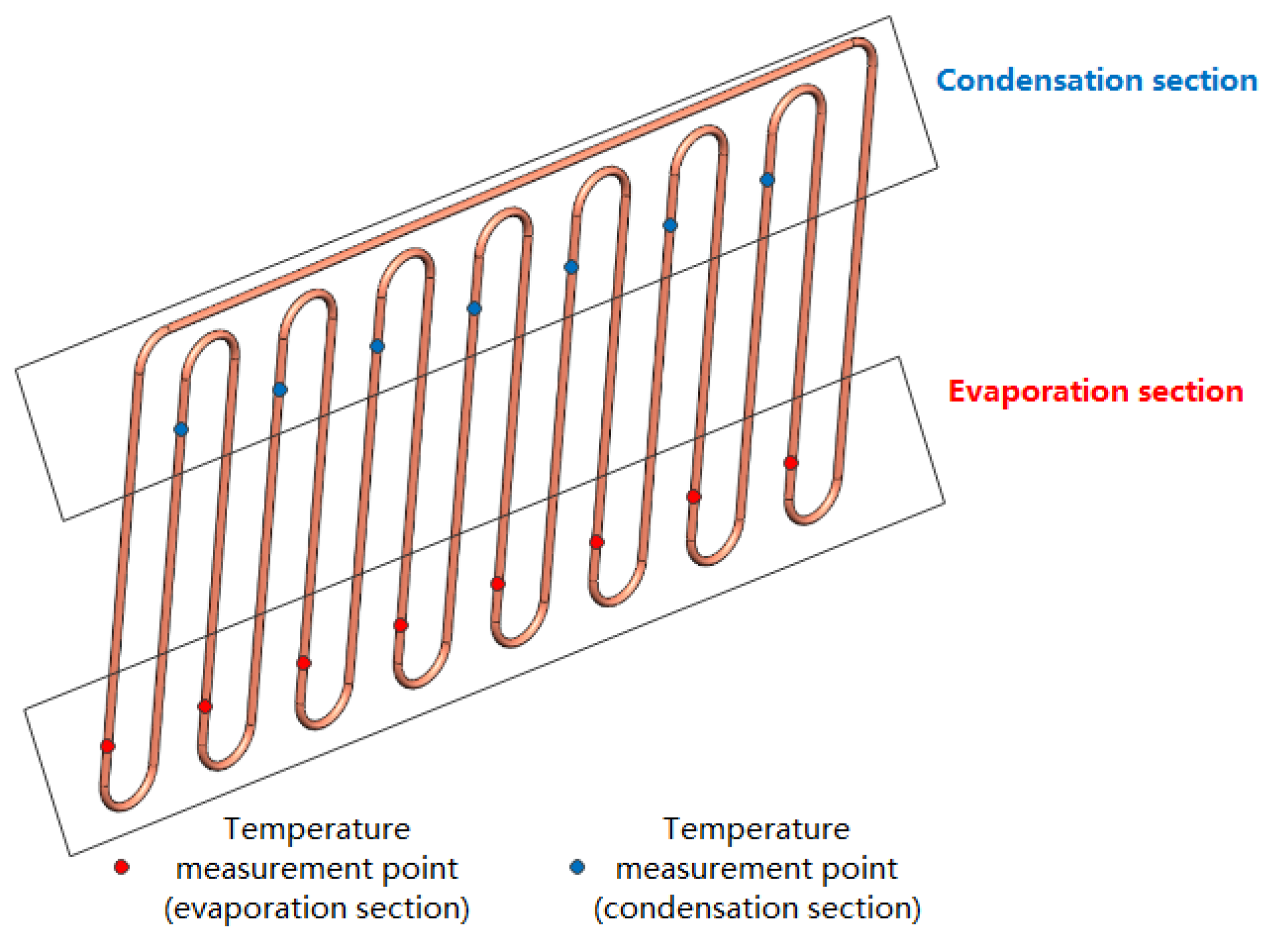


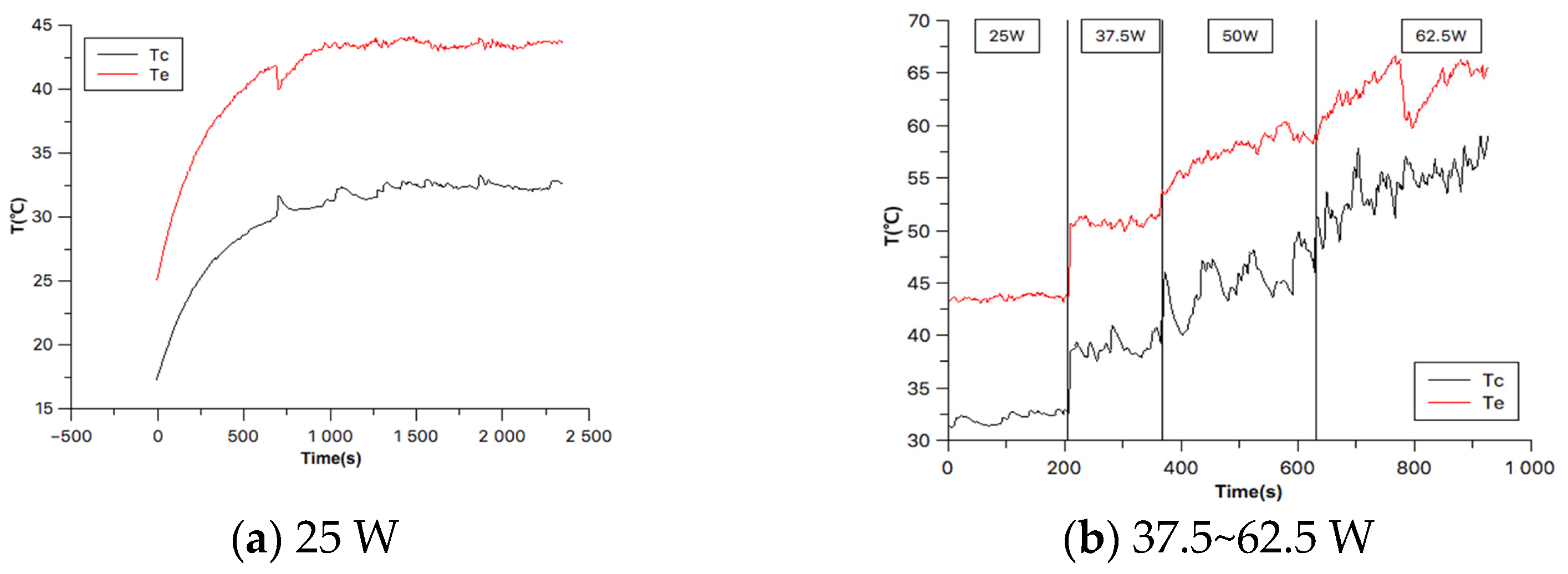
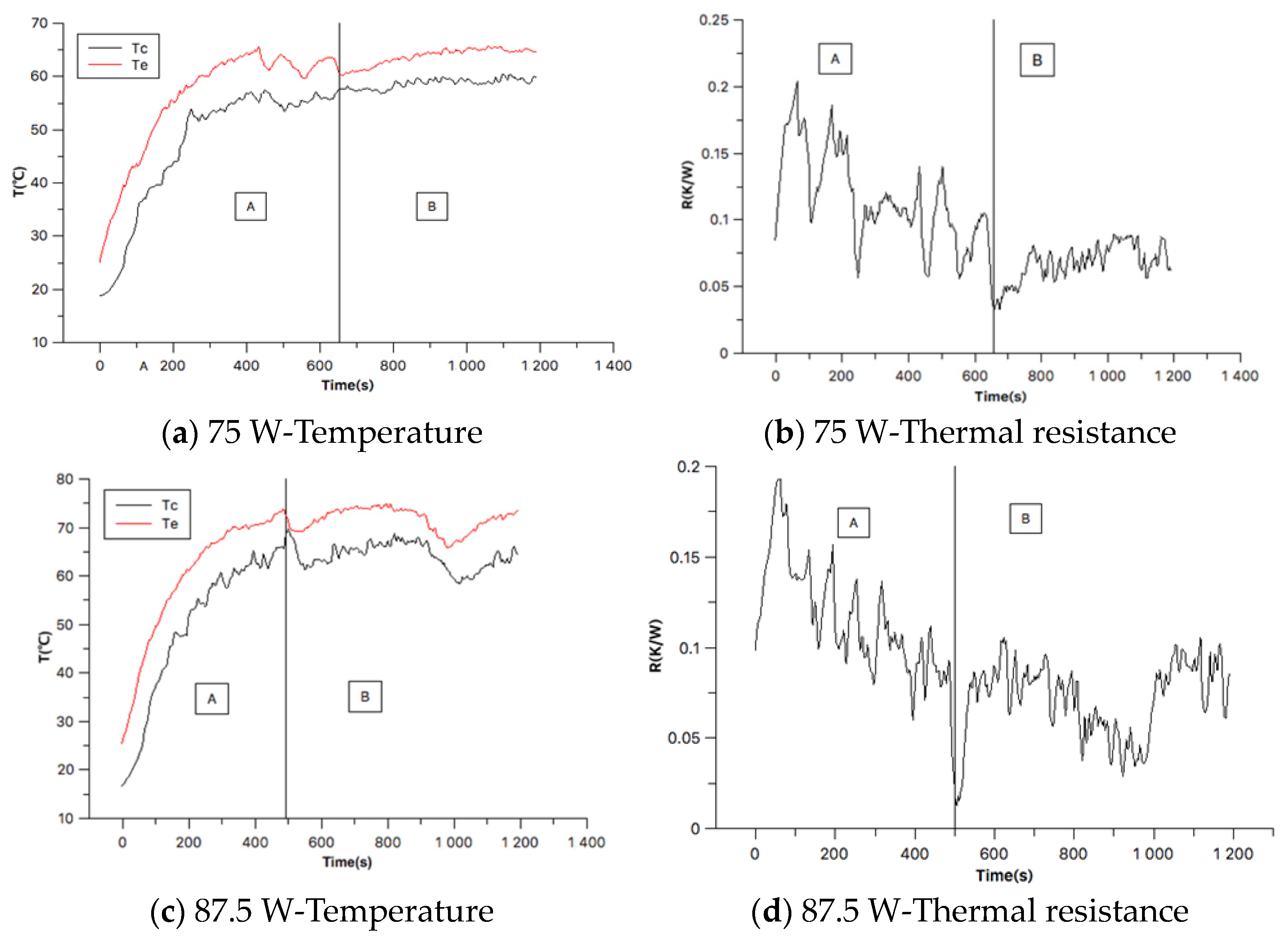
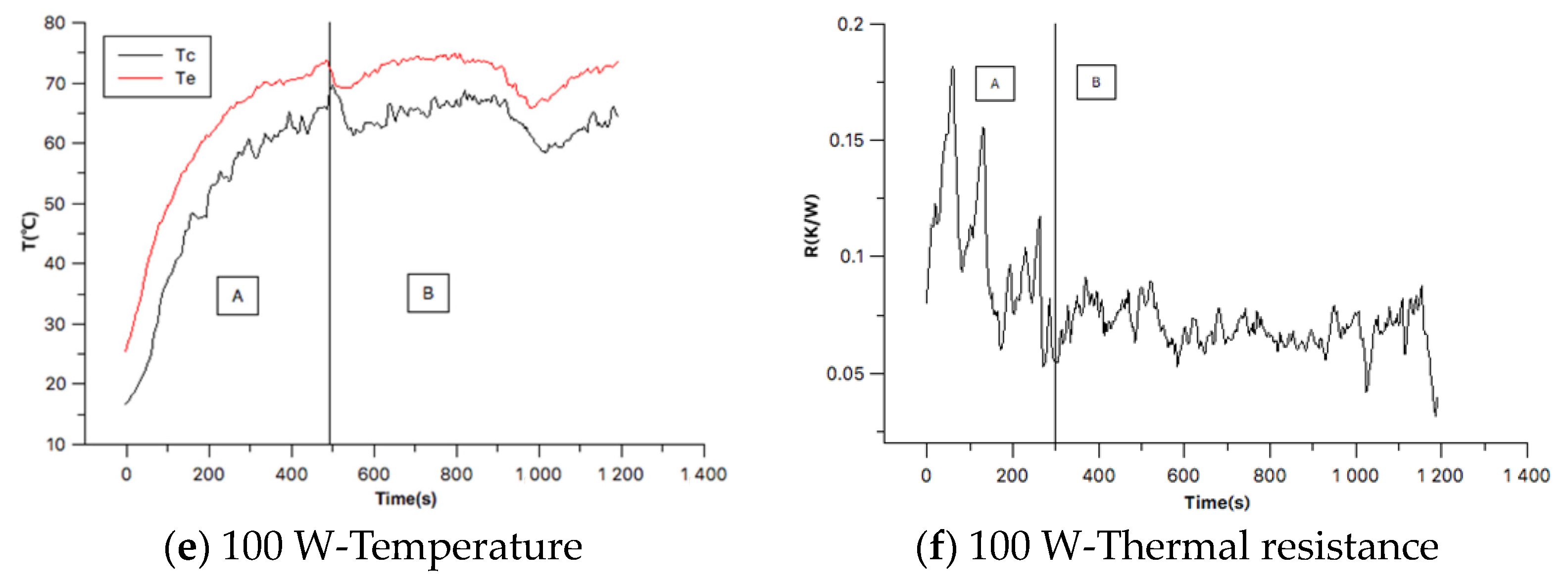



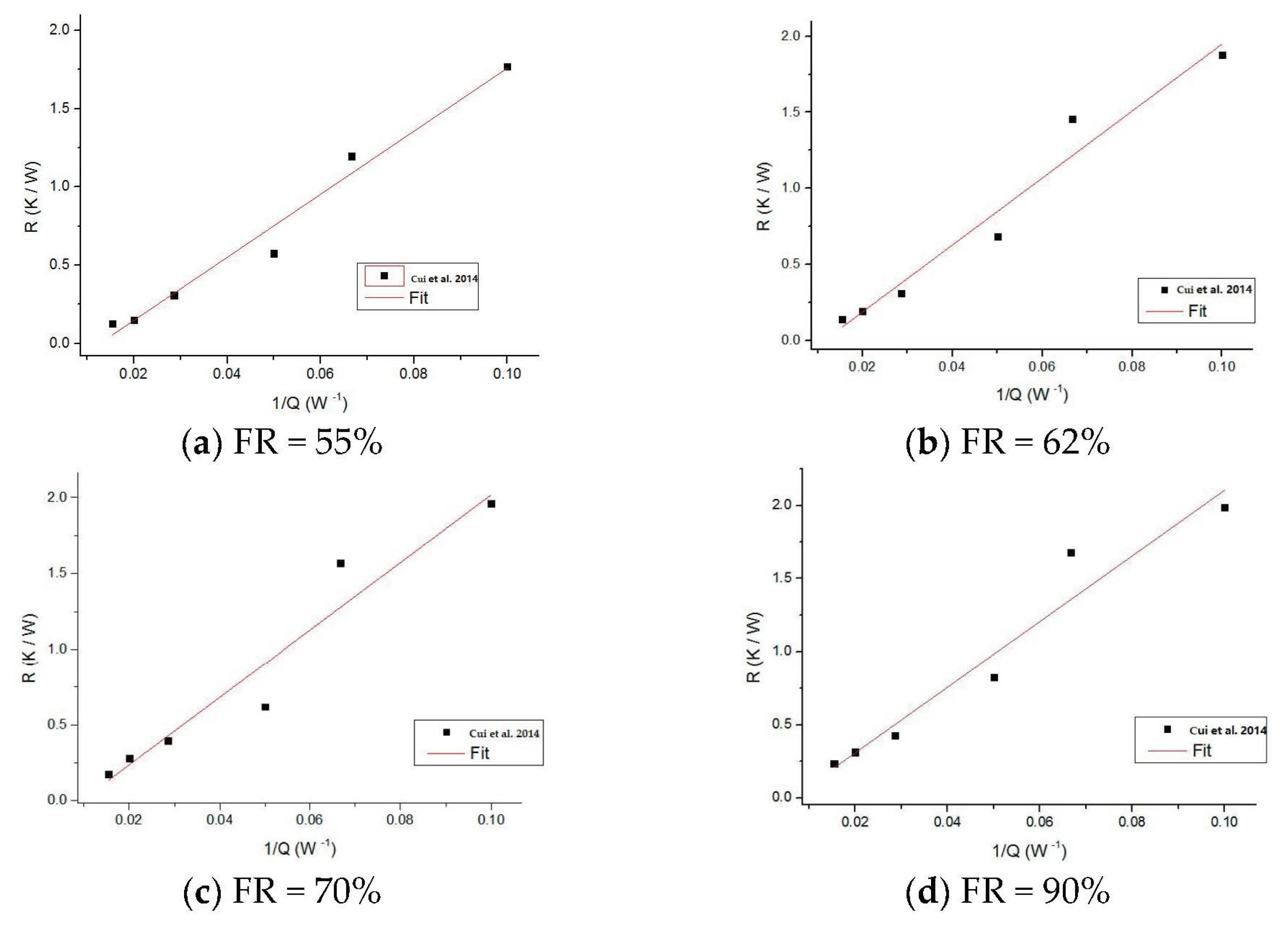
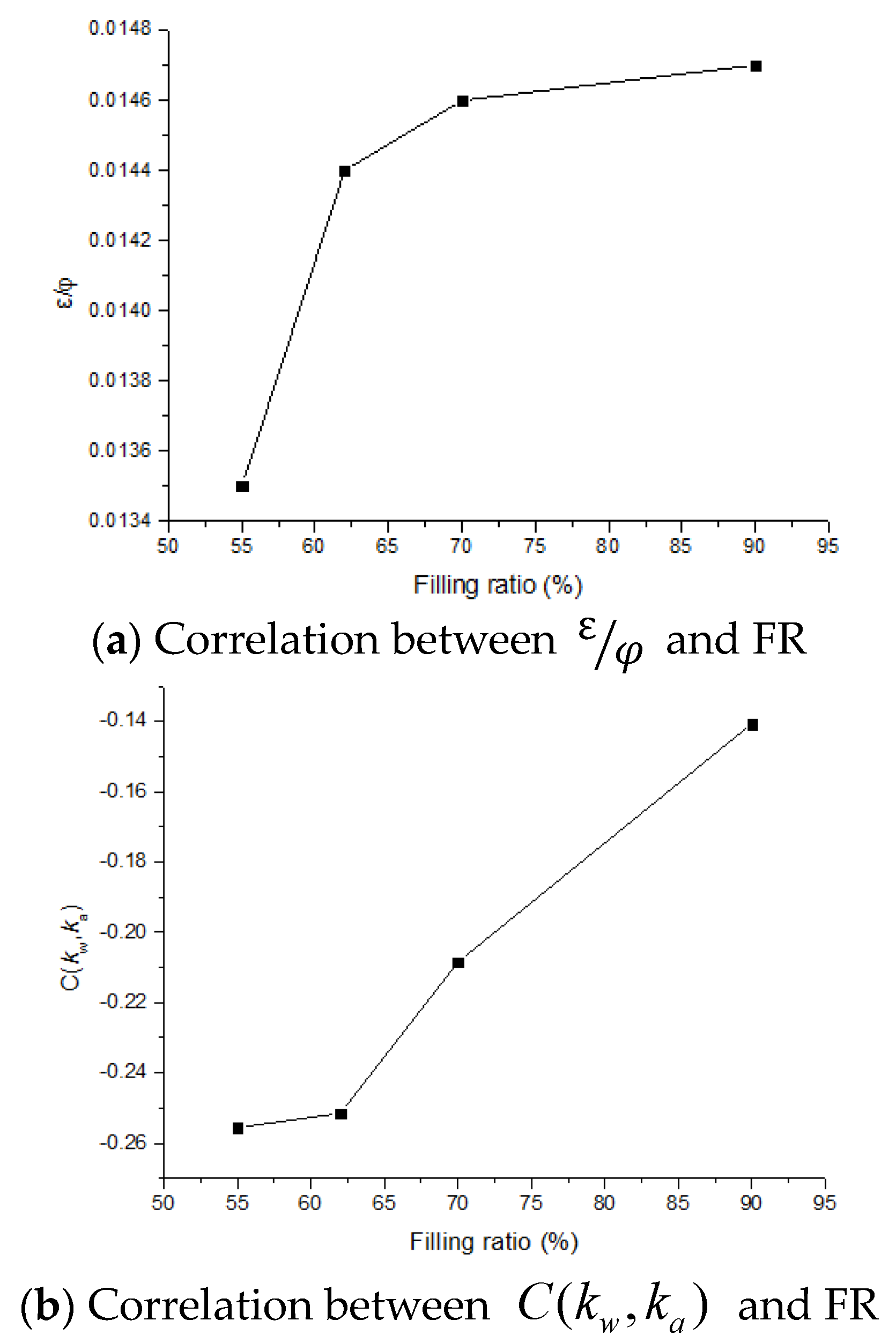
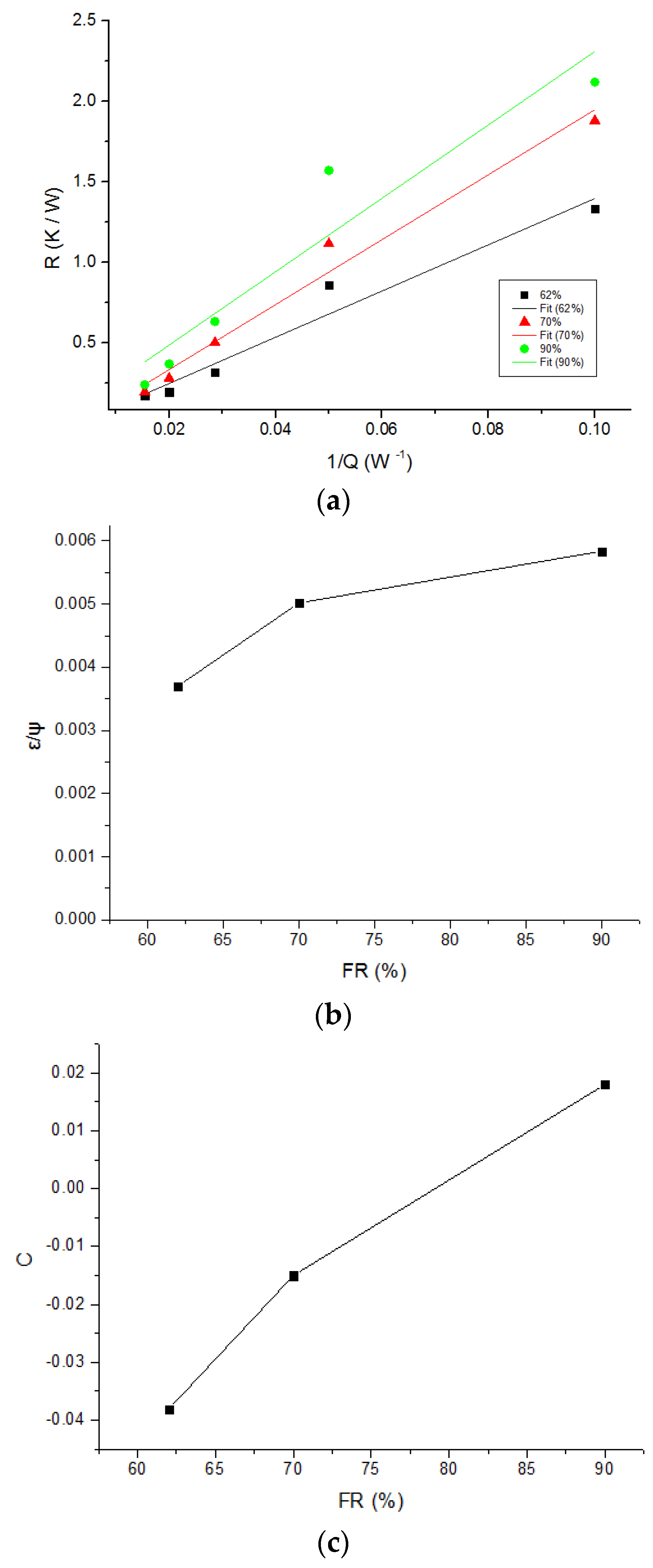
| Deionized Water | Methanol | Ethanol | Acetone | |
|---|---|---|---|---|
| −0.25154 | −0.0381 | −0.4767 | −0.041 |
Disclaimer/Publisher’s Note: The statements, opinions and data contained in all publications are solely those of the individual author(s) and contributor(s) and not of MDPI and/or the editor(s). MDPI and/or the editor(s) disclaim responsibility for any injury to people or property resulting from any ideas, methods, instructions or products referred to in the content. |
© 2023 by the authors. Licensee MDPI, Basel, Switzerland. This article is an open access article distributed under the terms and conditions of the Creative Commons Attribution (CC BY) license (https://creativecommons.org/licenses/by/4.0/).
Share and Cite
Ling, Y.; Li, X.; Zhang, X.; Liu, Z.; Zhao, P. Experimental and Theoretical Study on Operation Characteristics of an Oscillating Heat Pipe. Appl. Sci. 2023, 13, 8479. https://doi.org/10.3390/app13148479
Ling Y, Li X, Zhang X, Liu Z, Zhao P. Experimental and Theoretical Study on Operation Characteristics of an Oscillating Heat Pipe. Applied Sciences. 2023; 13(14):8479. https://doi.org/10.3390/app13148479
Chicago/Turabian StyleLing, Yunzhi, Xiaozhao Li, Xiaosong Zhang, Zhan Liu, and Peng Zhao. 2023. "Experimental and Theoretical Study on Operation Characteristics of an Oscillating Heat Pipe" Applied Sciences 13, no. 14: 8479. https://doi.org/10.3390/app13148479
APA StyleLing, Y., Li, X., Zhang, X., Liu, Z., & Zhao, P. (2023). Experimental and Theoretical Study on Operation Characteristics of an Oscillating Heat Pipe. Applied Sciences, 13(14), 8479. https://doi.org/10.3390/app13148479







